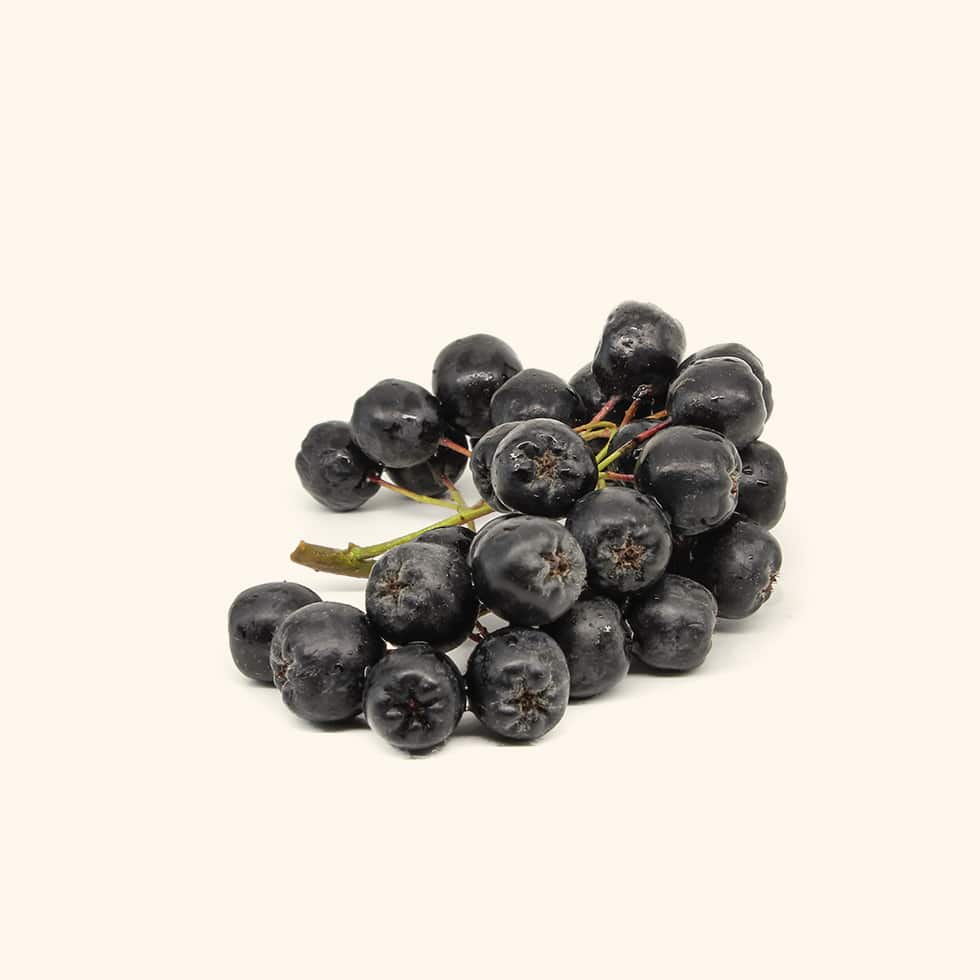Aronia (Black chokeberry)
- Zone 3Characteristics of the tree

Aronia, or black chokeberry, is a hardy fruit bush native to Eastern Canada, and famed for its nutritional benefits. It has a distinctive astringent and sweet taste. While some will enjoy it for fresh eating, it is appreciated by all in jellies, preserves and pies. It also displays genuine beauty and high ornamental value, and one of the easiest fruits to grow; without any known disease or insect problems to date.


Aronia, or black chokeberries, are small, round, jet-black berries about the same size as blueberries. They ripen in fall and hang on the bush for some time when ripe. Generally they can be harvested any time between late August to early October, depending on the area where they are grown – with more sugars and flavour developing the later they are harvested.
Aronia berries are quite firm in texture; with tiny, imperceptible seeds. The berry has a distinctive and complex taste which some will dislike and others appreciate. Its predominant flavour is astringence, and it is also very high in tannin, giving a ‘drying sensation’ in the mouth. This is balanced with sweetness, a small amount of acidity and a pleasant aroma. (Contrary to what is sometimes claimed, it is neither bitter nor strongly acidic in flavour.) If you like strong black tea, 90% chocolate and dislike very sweet things, you will very likely enjoy the taste of aronia.
Since many people find aronia too astringent to eat fresh out of hand, it tends to be mainly used in preserves, juices and baking, where it has a wide range of applications. We have found it particularly delicious when combined with other fruit into a flavourful juice. We have also used it to make excellent jellies and jams, and are still exploring its possibilities!
Along with sweet products, its flavours would probably make it interesting to use in savoury cooking in meat sauces, although this is something we have yet to experiment with ourselves.
One of the main reasons for interest in aronia is its nutritional value. It is exceptionally high in antioxidants (the highest of any fruit that has been tested, even higher than elderberry), and also contains high levels of vitamins and minerals. This does not mean it is a miracle cure-all (it is always good to be wary of hype), but it is definitely a very healthy fruit that will make a great addition to anyone’s diet.
Aronia is a small to medium shrub, generally not exceeding 1.5 metres in height with an upright bearing. Its growth habit can vary somewhat according to individual genetic differences, but the bush is generally fast-growing and sturdy, and will produce fruit within the first three years of being planted. Our plants are propagated from seed, and so each will have slightly different characteristics. They will also pollinate each other to give higher fruit yields if more than one bush is planted, but this is not absolutely necessary, as aronia is self-fertile and produces fruit even when planted alone. Overall it is easy to grow: hardy to zone 3, self-fertile, and untroubled by diseases and insects. It grows best in full sun but can tolerate semi-shaded conditions, and it needs well-drained soil.
It’s interesting to note that although aronia is native to Eastern North America, it is currently much more commonly cultivated in Europe, where cultivation of it began several decades ago. It has even spread into the wild in Poland, after escaping from cultivation. About half of all aronia cultivated worldwide are cultivated in Poland! Meanwhile in North America, although the demand for aronia and products made for it is growing apace, commercial production of the berries is still relatively rare.
Aronia is a very beautiful-looking shrub, with profuse pink or white flowers in late spring, and a wonderful show of fiery red foliage in the fall. Its berries also look very pretty, as they hang on the tree like decorations. In fact, aronia has often been used for landscaping and ornamental purposes by those who have no idea that the fruit is edible. It would make a lovely edible and flowering hedge: if you wish to use it for this purpose, you can space the plants 1 metre apart.
Aronia grows as a small or medium-sized shrub, generally reaching around 1.5 metres in height, with an upright growth habit. The bush is generally fast-growing and sturdy. It will produce fruit within the first three years of being planted. The roots tend to sucker and produce new shoots from the base of the plant, but with limited spreading.
You should note that this illustration is meant only to give a general indication of what you can expect, and the growth of your tree might look somewhat different. The development of a tree depends on the soil type, irrigation, fertilisation and climatic conditions. What we show here is based on our observation of the growth of aronia bushes in zone 4, in rather poor soil. In zone 2, growth will probably be slower, while in a rich soil it could be faster.

All our aronias are sold bare-root, without pots. They have been cultivated directly in our soil. Bare-root trees must be taken out of the ground and shipped during their period of dormancy, which is why we only ship trees in the spring. A big advantage with these kinds of trees is that they take up very little space, and can therefore be easily shipped by mail all over Canada!
















